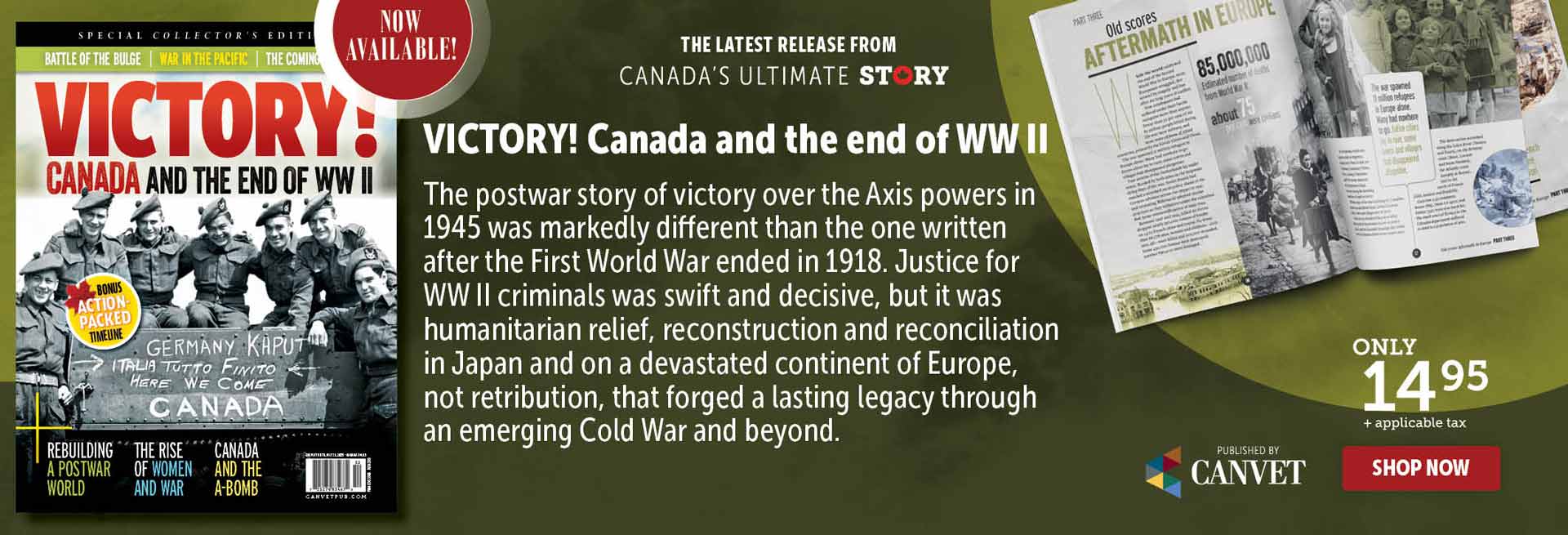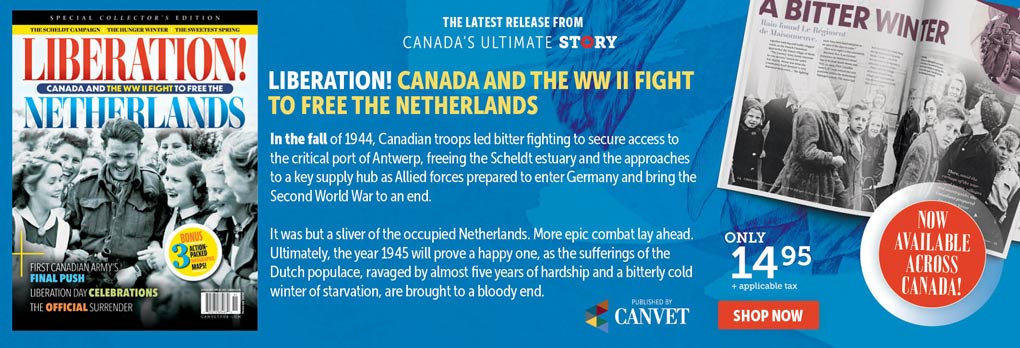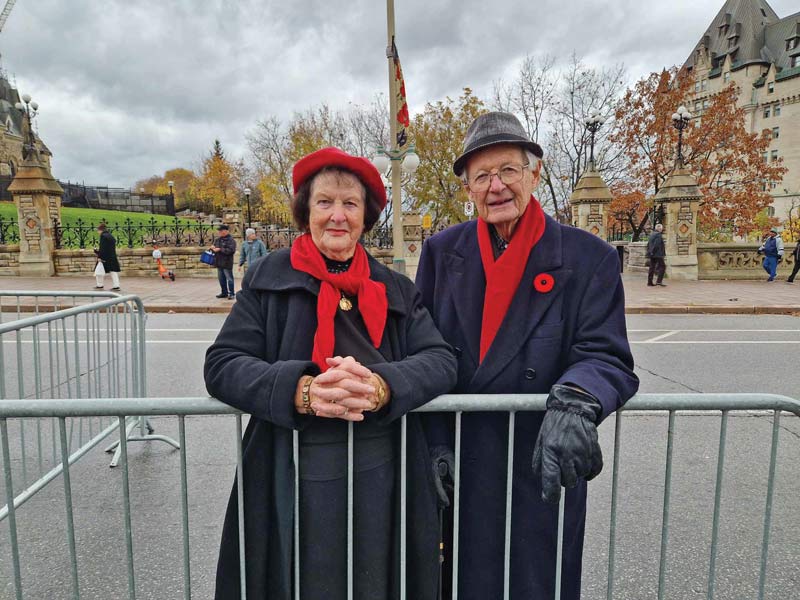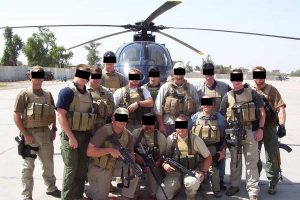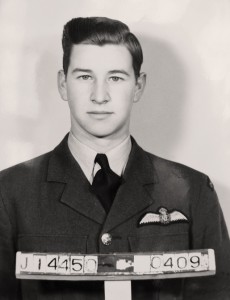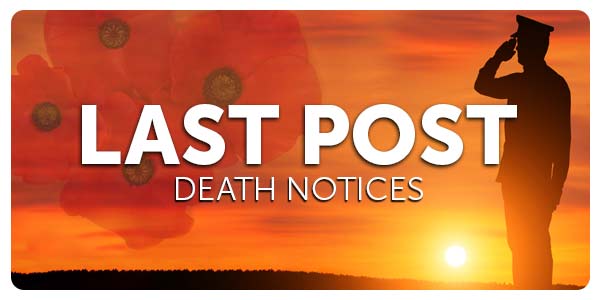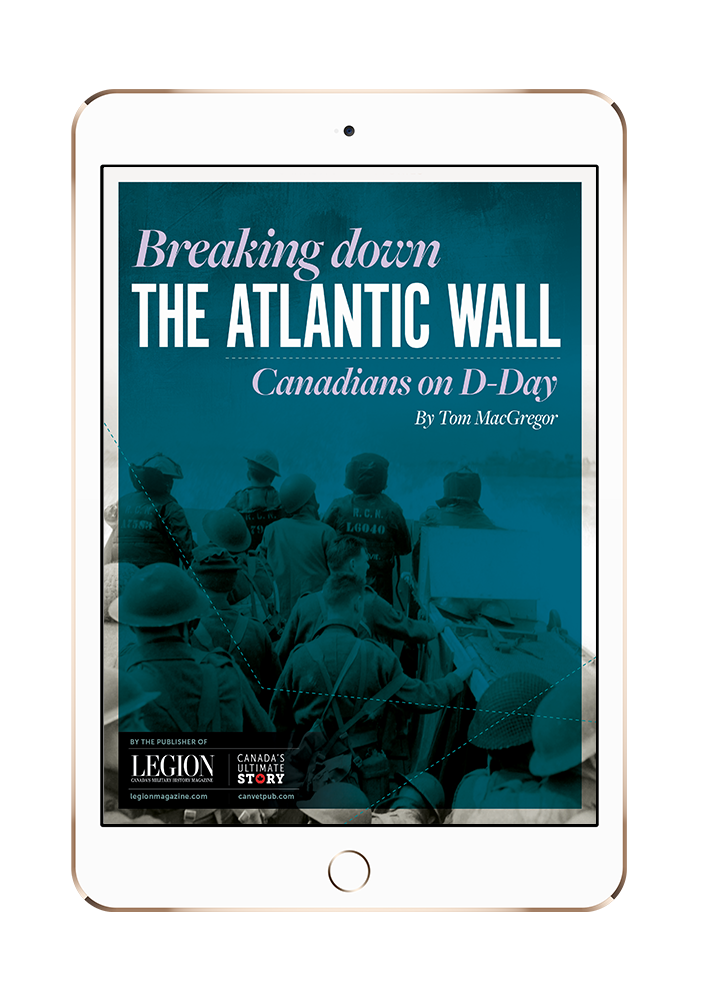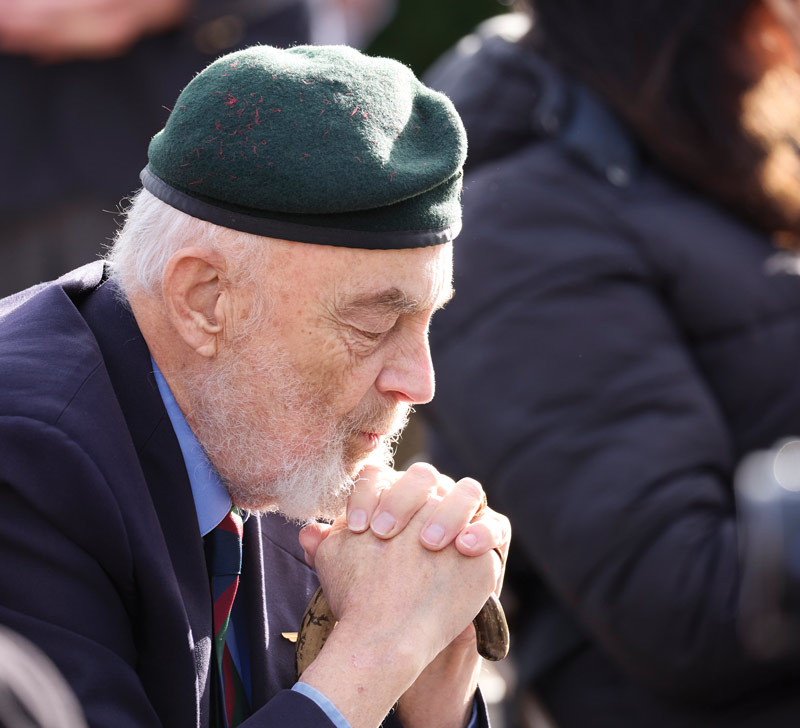
A veteran pauses for a moment of reflection during the national Remembrance Day ceremony. [Melody Maloney/Metropolis Studio]
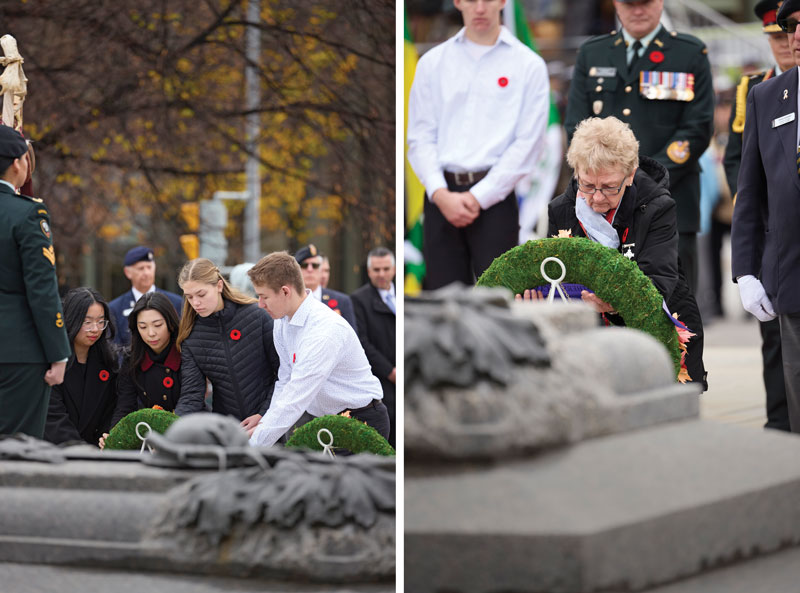
Senior-level winners of The Royal Canadian Legion’s National Youth Remembrance Contests place a wreath on behalf of the country’s youth. [Melody Maloney/Metropolis Studio]
Their action reminds us of the strength of unity; it is in that unity that we find hope and resilience.

National Memorial (Silver) Cross Mother Maureen Anderson places a wreath. Chaplin General Guy Bélisle leads prayer at the event. [Melody Maloney/Metropolis Studio]

Sentries representing the navy, air force and army stand watch at the National War Memorial. [Melody Maloney/Metropolis Studio]
Cesar Vanneste was six years old when he witnessed the liberation of his Belgian village, the date—Sept. 6, 1944—having long since been etched in his mind.
“My father told me [and three brothers] to stay away from the windows,” he said. “Of course, boys being boys, we looked anyway, but we didn’t see anything.”
Now in his late 80s, the Kanata, Ont., resident recalled the moment when he at last glimpsed the Canadian and Polish soldiers who secured his community, albeit at the cost of further bloodshed in the streets after an enemy sniper opened fire.
It was a sacrifice that Vanneste, clad in a blue coat and red scarf to protect against the crisp November breeze, could never forget. Being present for Ottawa’s Remembrance Day 2024 commemorations—his 54th year of attendance, according to his similarly attired wife Ellen Marie—was one way of paying tribute to them.
Such was the overarching sentiment throughout the crowd of an estimated 35,000 spectators, even if each had their own private reasons for having gathered at the National War Memorial—some several hours before the formal event.
For Ottawa local Heather Dorward, a framed picture of her late veteran father hanging around her neck, that reason was more on the surface than others.
“He passed away in February,” she explained of Thomas Dorward, a former NATO medical assistant once stationed in Germany, acknowledging that his later role in the reserves meant “I didn’t lose him too much” as a child. “But a lot of families lost time with their [serving] loved ones, and then some lost them altogether.”
Elsewhere, Elizabeth King and Catherine Elliot Shaw of London, Ont.—both members of The Royal Canadian Legion’s Vimy Branch—wished to honour all fallen.
“I’ve watched it on television many times,” noted Shaw, “but this is the first time in person. That makes it very special. It is a very special day across Canada.”
That it was, as spontaneous chatter between strangers, diverse in background but finding commonality in remembrance, gradually increased with the crowd growing. Others, meanwhile, chose silent reflection, staring out toward the final preparations around the monument, seemingly lost in their thoughts.
By about 9:30, a palpable shift in mood descended over the coffee-carrying masses. Gone was much of the laughter, replaced by sombre rumination. With flags fluttering in the wind, the clouds began to recede and sunshine beamed down.
Among those in the spotlight at this year’s event was 98-year-old John Preece, who fought for the liberation of Nazi-occupied Europe as a private.
Despite the temporary attention he received, Preece felt “forgotten,” recognizing that “there’s hardly anybody around anymore, so it’s nice to represent them.”
With few exceptions, the widespread absence of Second World War veterans was hard to ignore as dozens of former service members, including many wearing the blue berets of peacekeepers, paraded down Elgin Street to the sound of bagpipes and drums, all greeted with applause as they passed.
Such a constantly changing sea of faces seemed more inevitable than ever, a fact not lost on most in attendance, yet with it came the realization that Canada and the world now stand at a proverbial minute to midnight with the generation that once confronted fascism some 80 years ago. Equally, the oft-underrepresented Korean War veterans, most of a similar age as their WW II comrades, have likewise had their ranks diminish significantly over the decades.
Darkening clouds and a slight chill returned shortly after the sentries took their posts, a seamless procedure observed from rooftops, windows and lampposts. Commanded by Royal Canadian Air Force Sergeant Kevin James, the personnel selected to stand watch over the monument were Master Sailor Jed Garcia; Master Corporal Jeffrey Steel of the Canadian Special Operations Forces Command; Master Bombardier Mikael Nicol-Charette; RCMP Sergeant Cara Streeter; Master Corporal Linda Kamenawatamin of the Canadian Rangers; and Captain Kathleen Nguyen of 1 Canadian Field Hospital.
The formal ceremony commenced just after 10:30. Prime Minister Justin Trudeau greeted RCL Dominion President Berkley Lawrence, thanking him for his service, before shaking hands with the organization’s national executive director Steven Clark.
This year’s National Memorial (Silver) Cross Mother Maureen Anderson arrived shortly thereafter wearing two crosses for her sons, Sergeants Ron and Ryan Anderson. Both veterans of the war in Afghanistan, the brothers lived with post-traumatic stress disorder afterward, a factor that directly related to their untimely deaths. At a luncheon the previous day, Anderson had struggled to speak about her tragic losses. Lawrence met her at the Remembrance Day ceremony with a warm embrace.
Next to arrive was Gov. Gen. Mary Simon, who, as commander-in-chief of the Canadian Armed Forces, wore her RCAF uniform to mark the branch’s centenary, one of the event’s two main themes. The 80th anniversary of D-Day was the other.
As the clock neared the 11th hour, almost all the crowd stood in silence, most having done so long before “Last Post” was played. A spirited rendition of “O Canada,” performed by the Ottawa Children’s Choir, preceded the bugler’s haunting notes that then seemed to echo off buildings down Elgin Street.
Quiet contemplation continued during the 21-gun salute carried out by 30th Field Regiment, Royal Canadian Artillery, save for the cries of a single startled child. No one appeared disturbed by the tears, however, for many had tears of their own.
Only the piper’s “Lament” could stir attendees from their musings, along with the rumble of four CF-18 Hornet aircraft during a flypast. Corporal Malcolm Horava’s playing of “The Rouse” signified the end of the silence, although the spirit captured in two minutes lingered like the artillery smoke drifting from Parliament Hill.
Three versions of the Act of Remembrance were recited in short order, the first in English by Lawrence, the second in French by RCL Grand President Larry Murray and a third by Métis veteran Robert Baskey in northern Ontario Michif. Regardless of language, the sentiment moved spectators with each reading.
Then it was time for Chaplain General Guy Bélisle to offer the long-held tradition of prayers, remarking that “in the spirit of peace and gratitude, this moment prompts us to reflect on the sacrifices of our heroes and their families.
“Their action reminds us of the strength of unity; it is in that unity that we find hope and resilience in the face of the challenges our world continues to put before us.”
That unity likewise appeared to be on full display for the placing of the wreaths, carried out while the Ottawa Children’s Choir performed “In Flanders Fields.” Simon and her husband Whit Fraser initiated the tribute, followed by Anderson, Trudeau, Assistant Deputy Speaker of the House of Commons Carol Hughes, Veteran Affairs Minister Ginette Petitpas Taylor, Defence Chief General Jennie Carignan, the Legion National Foundation’s senior poster and literary contest winners, and the RCL’s Lawrence.
The rain held off for as long as it could, but droplets soon fell on the undeterred delegation left to pay their respects, including members of the diplomatic corps and various veterans’ groups. Rabbi Idan Scher, the multi-faith representative, seemed not to mind the cold and wet as he stood at the podium to give the benediction.
“In a world often divided,” he said, “the unwavering bond among our troops serves as a beacon of strength for us all. The Canadian Armed Forces reflecting our nation’s rich diversity remind us of the remarkable achievements possible when we stand together for a cause greater than ourselves.”
The choir’s singing of “God Save the King” concluded the ceremony, whereby much of the viceregal party remained to shake hands before departing the memorial. Simon then invited Anderson to join her on the reviewing stand as they observed the parade, flanked by Trudeau and Lawrence.
“Thank you, thank you, and God bless,” shouted Ellen Marie Vanneste as the veterans and active service members marched off. Expressing a heartfelt desire to stand in the exact same place at the exact same time in 2025, for a 55th year, there was no doubt of her and husband Cesar’s shared commitment to the sacrifices of Canada’s military.
They were not alone.
Indigenous Veterans Day
On Nov. 8, 2024, a separate ceremony took place at Ottawa’s National Aboriginal Veterans Monument for Indigenous Veterans Day, recognizing the sacrifices of First Nations, Inuit and Métis military personnel across Canada. Featuring many of the traditional elements associated with Remembrance Day, the event also included the presence of the Canadian Forces Eagle Staff and the sharing of Indigenous songs.
“It was very, very important for me to be there,” said Colonel David Grebstad, deputy commander of the Canadian Armed Forces Transition Group and citizen of the Red River Métis. “And I also think it’s important to spread the word.”
More than 4,000 Indigenous soldiers served in the First World War and at least 3,000 during the Second World War, an overwhelming number of whom returned home only to endure the racism and discrimination they had left behind.
“Many were denied the benefits granted to their non-Indigenous colleagues,” explained Grebstad, who likewise operates within the Defence Indigenous Advisory Group, an organization established to represent Indigenous public service employees working for National Defence and the Canadian Armed Forces.
Today, as ever, service members from First Nations, Inuit and Métis communities contribute significantly to Canada’s military institutions, whether through NATO operations in Europe, UN peacekeeping missions or the country’s own defence.
Canadian Army commander Lieutenant-General Michael Wright was among the guests to deliver remarks at the commemorations. Days earlier, he released a statement noting that: “We cannot change the past but we can, and must, continue to value Indigenous cultures in our work every day of the year.”
Advertisement






